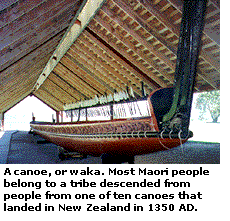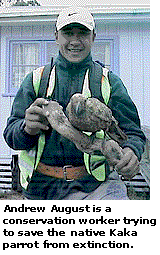 |
My Visit with Maori People |
 |
|||
| Te Whaiti Dressed in skirts made from flax, eight young men stomped their feet in time and slapped their bare chests. They chanted a fierce Maori song, their eyes wide and glaring. A shiver went down my spine. The young men were doing the haka, a war dance and chant to prepare for battle. They danced for their people with pride, the spirits of their ancestors with them. It was a Maori cultural evening at Te Whaiti, which is a town in the Whirinaki Forest, south of Rotorua. Although the boys were fierce, the girls sang beautifully, using the poi, balls of flax fibers on strings that are swung in time to songs. The children of Te Whaiti are descended from southeast Asian people who long ago took to the sea in double-hulled canoes and settled the islands of the Pacific. Sometime before A.D. 900 , the Maoris arrived at Aotearoa, what we call New Zealand. The people of Te Whaiti are of the Tuhoe tribe, known as the Children of the Mist. In legend, they are the offspring of a mortal man and an immortal being of the forest, known as the Mist Maiden. Whakapapa, or who you are related to, is a key part of Maori culture. Most Maori people belong to a tribe, or iwi, descended from people from one of ten canoes that landed here in A.D.1350. The iwi are divided into sub-tribes, or hapu, in which everyone is related. Each sub-tribe has sacred ground, known as a marae, in front of the village's meeting house. So what does it mean to be Maori today? During my trek I have stayed with a number of Maori people, including a school principal, a man who used to be a professional wrestler, and a man who is working to save native parrots from extinction. Most Maori people have adopted the lifestyle of the European colonists who have settled the islands since 1800 — they live in regular houses, do regular jobs, and dress in regular clothes. At the same time, Maori culture is very strong. Many schools teach in the Maori language and train the children in the ways of their ancestors. Intricate carvings, artwork, music, dance, and traditional buildings all form part of the Maori heritage. The Maori people had no written language until the Europeans arrived, so all traditions were handed down orally. They used songs and carvings to tell stories of the past that held lessons for the young. The Maori traditionally believed in gods that represented forces of nature. Two such gods were Papa tu a nuku, the Earth Mother, and Ranginui, the Sky Father. Their children included Tane, lord of all living things. In legend, he separated the Sky from the Earth and let light fall upon the land. Today, many Maori people have adopted Christianity, or a combination of traditional beliefs and Christianity. The Maori people are passionate, humble, warm-hearted, and friendly — but also fierce when they need to be. Above all, the Maori people are survivors. In their past, disease and wars — both with European settlers and between themselves — reduced their population to only 40,000. Today, however, there are about 350,000 people with Maori ancestry. Traditionally the Maori people had a strong connection to the land. I spent several days in the Whirinaki Forest with Andrew August, a Maori man who works to protect the native kaka parrot. Before entering the forest, Andrew stopped to say a karakia, a prayer to ask for protection and show respect for the trees. This respect for living things and elders is what has impressed me most about Maori culture.
Otaki Spirituality, respect, and belonging to an extended family have given strength to the Maori people of New Zealand and allowed them to hold on to their culture in a changing world. |

|
||||


